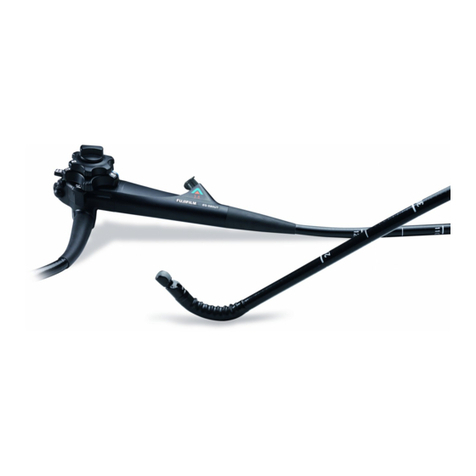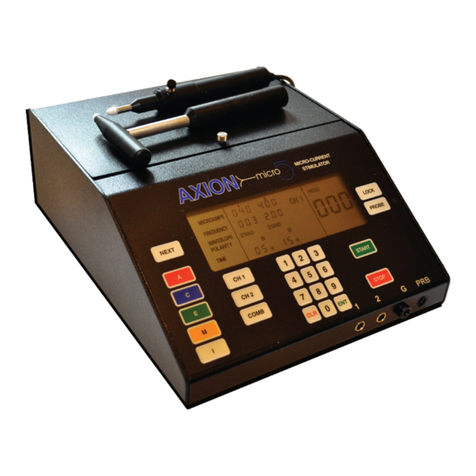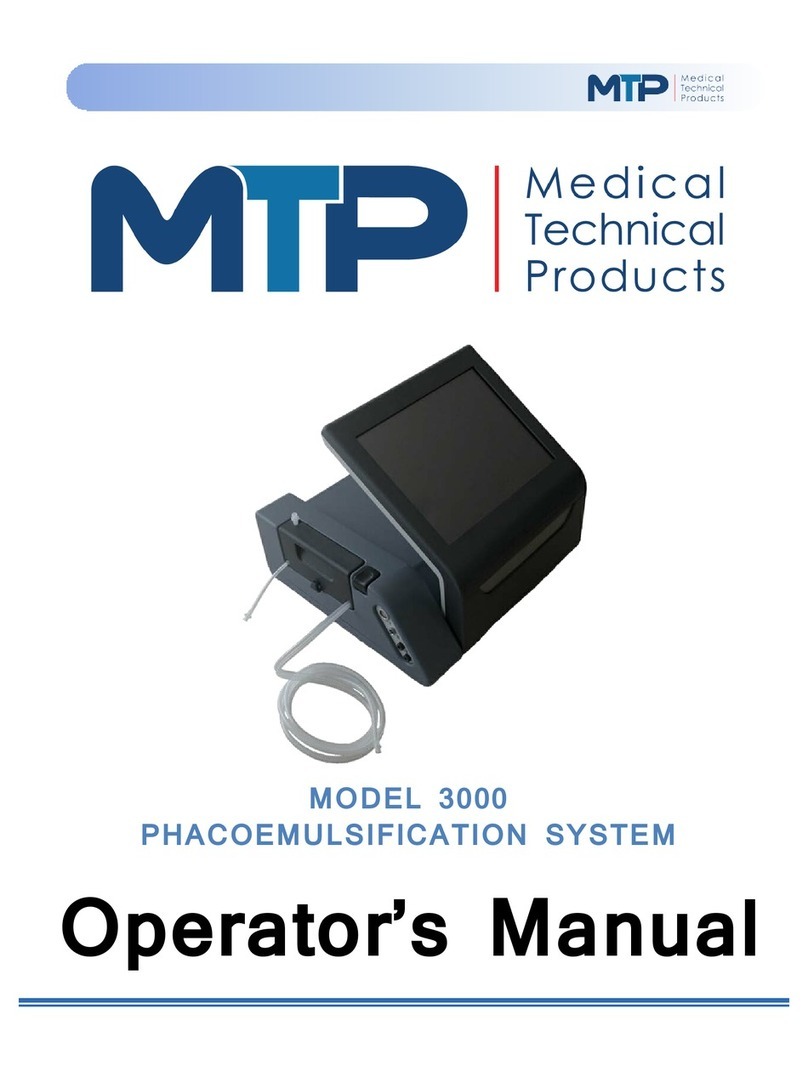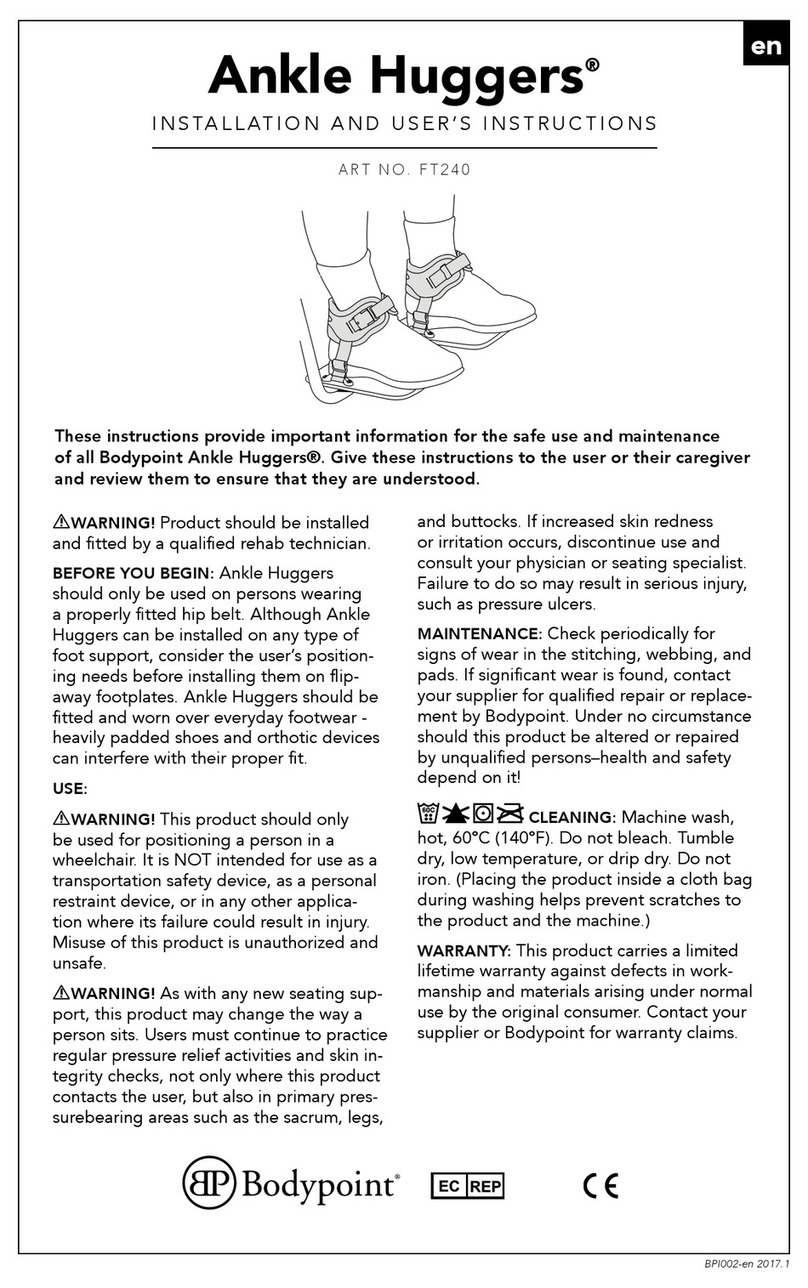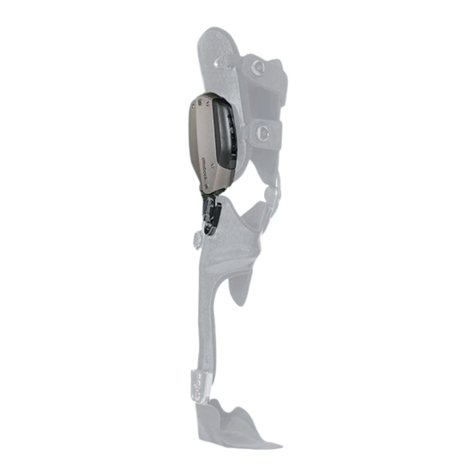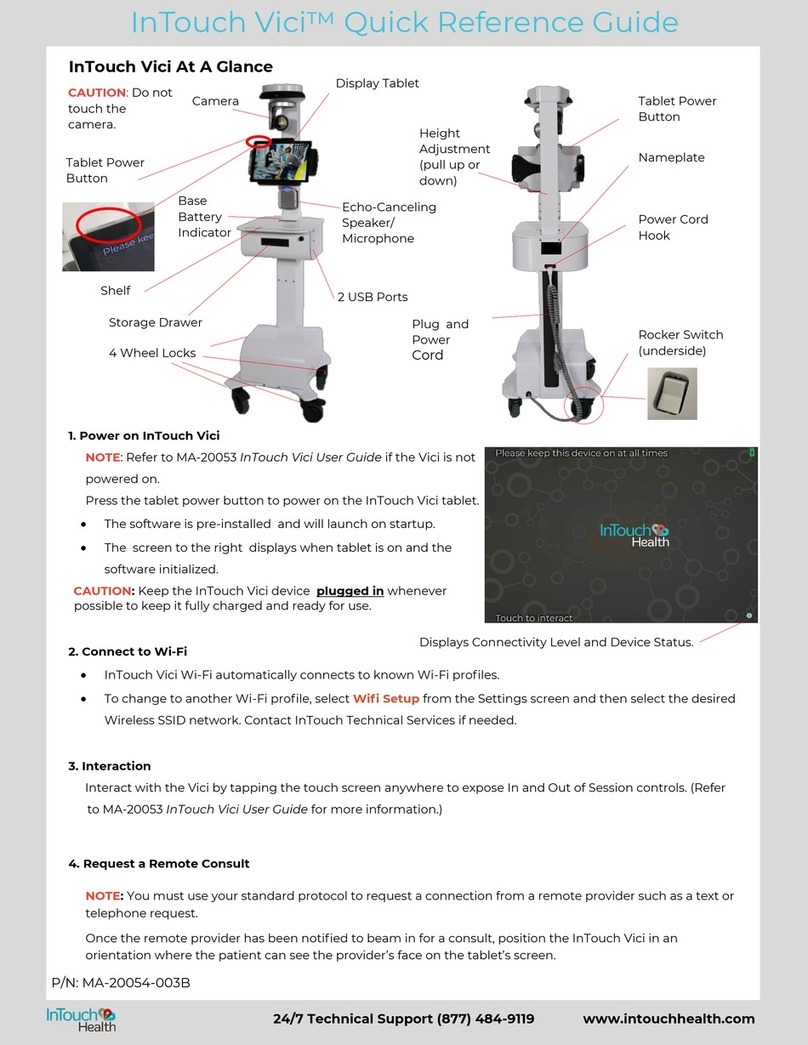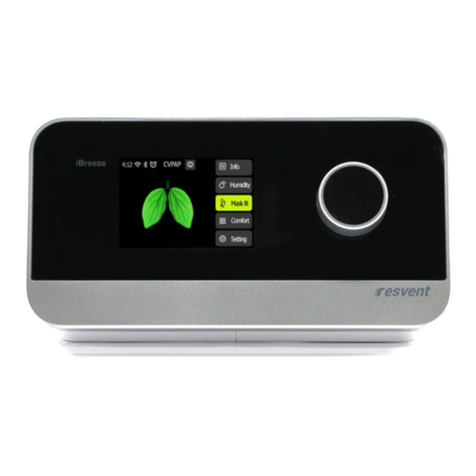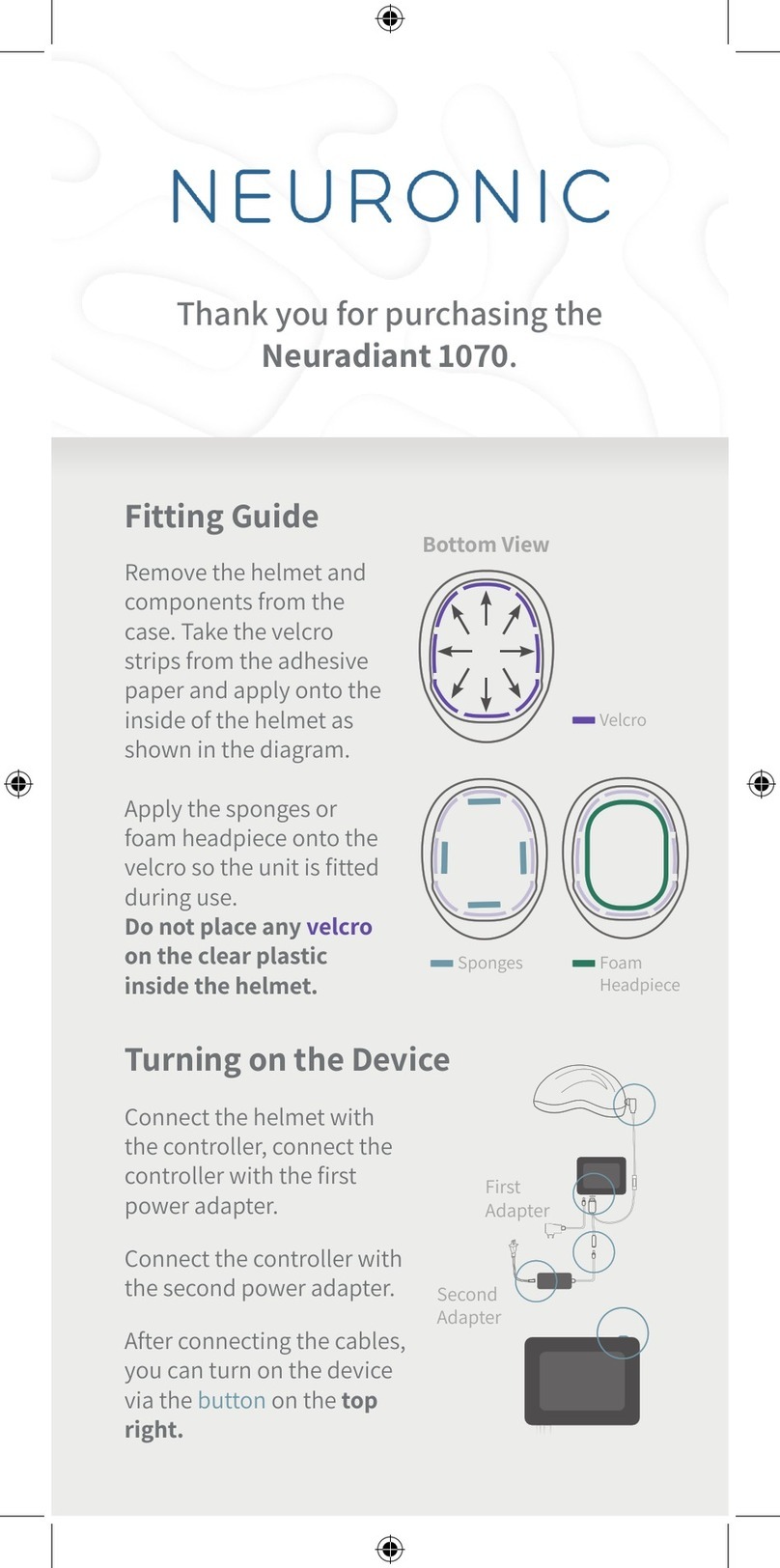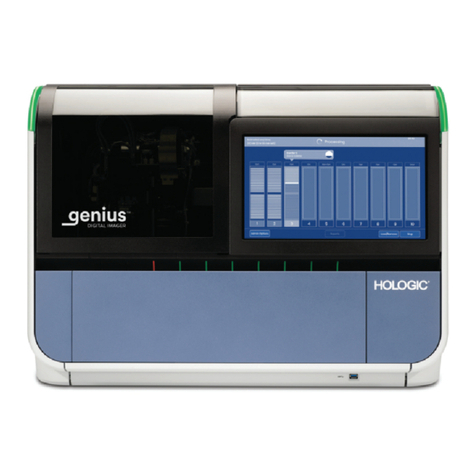Chattannoga OptiFlex SHOULDER CPM User manual

USA/GB
ES
Operating Instructions
Modo de empleo
SHOULDER CPM
OPTIFLEX S Gebr DV2 e 709 25.09.2007 11:16 Uhr Seite 1

2
10
9
876
21 22 29
4
28
12
11
Descripción del aparato
2
1 3
14
23 24 20
16
15
18
13
5
25
26
30
27
19
17
Device description
OPTIFLEX S Gebr DV2 e 709 25.09.2007 11:16 Uhr Seite 2

3
DA
EB
FC
Illustraciones
Figures
OPTIFLEX S Gebr DV2 e 709 25.09.2007 11:16 Uhr Seite 3

4
Device description 2
Figures 3
1. How to use the CPM device 5
1.1 Fields of application 5
1.2 Therapy objectives 5
1.3 Indications 5
1.4 Contraindications 5
2. OptiFlex®S description 6
2.1 Description of the device components 6
2.2 Description of the programming unit 7
2.3 Explanation of symbols (connections and nameplate) 11
3. Safety information 12
4. Device setup 15
4.1 Connecting the device, performance check 15
4.2 Adjusting the device to the patient 16
5. Setting the treatment values 18
5.1 General information on programming OptiFlex®S18
5.2 Programming OptiFlex®S20
5.3 Treatment value details 20
5.4 Examples of use/sample protocols 25
6. Care, Maintenance, Transport, Conversion 27
6.1 Care 27
6.2 Maintenance (fuse replacement) 27
6.3 Transport 28
6.4 Conversion 30
7. Environmental Protection Statement 31
8. Specifications 31
9. IEC 60601-1-2:2001 32
9.1 Electromagnetic emissions 32
9.2 Electromagnetic immunity 33
9.3 Recommended separation distances 35
10. Contact 35
11. Technical Service 36
11.1 Technical hotline 36
11.2 Shipment 36
11.3 Spare parts 36
Contents
OPTIFLEX S Gebr DV2 e 709 25.09.2007 11:16 Uhr Seite 4

English
OptiFlex®S is a motor-operated Contin-
uous Passive Motion (CPM) device
providing motion to the shoulder joint.
Suitable for use in hospitals, clinics,
general practices and rental services, it
is an important supplement to medical
and therapeutic treatment.
CPM therapy with OptiFlex®Sis mainly
used to prevent the negative effects of
immobilization, to allow patients to
regain painless mobility of joints at an
early stage and to promote healing and
achieve a positive functional result.
Other objectives of therapy include:
- improvement of joint metabolism
- prevention of joint stiffness (arthrofi-
brosis)
- promotion of the regeneration and
healing of cartilage and damaged
ligaments
- faster hematoma/fluid resorption
- improved lymph and blood circulation
- thrombosis and embolism prophylaxis
The CPM device is indicated in the
treatment of most injuries and postop-
erative conditions and diseases of the
shoulder joint.
Examples:
- joint distortion and contusion
- arthrotomy and arthroscopy proce-
dures in combination with synovec-
tomy, arthrolysis or other intra-articular
interventions
- all types of arthoplasty
- mobilization of joints in anesthetized
patients
- operative treatment of fractures,
pseudoarthrosis, if exercise-stable
- decompression surgery (acromio-
plasty)
- endoprosthetic implants
- soft tissue surgery in the armpit and
the shoulder girdle
- tumor surgery in the shoulder region
Do NOT use OptiFlex®Son patients
with:
- acute inflammatory processes in the
joints, unless on the order of a physi-
cian
- spastic paralysis
- unstable osteosynthesis
1.4 Contraindications
1.3 Indications
1.2 Therapy objectives
1.1 Fields of application
1. How to use the CPM device
OPTIFLEX S Gebr DV2 e 709 25.09.2007 11:16 Uhr Seite 5

The motorized CPM device supports
the following movements of the shoul-
der joint:
Adduction/abduction 0° - 30° - 175°
Internal/external 90° - 0° - 90°
rotation
Elevation (flexion) 0° - 30° - 175°
with elbow bent between 60° and 90°
Horizontal adduction/ 0° -120°
abduction
(manual adjustment only)
It can be reconfigured for use on either
side.
These are some of the outstanding
OptiFlex®Sfeatures:
- anatomically correct setup
- physiological movements
- maximum possible ranges of motion
- programming unit for precise adjust-
ment of patient-specific therapy
values
- chip card for storage of the pro-
grammed therapy parameters
- easy transport
Biocompatibility
Those parts of the OptiFlex®Sdevice
that come into contact with the patient
when the device is used as intended,
are designed to fulfil the biocompatibility
requirements of the applicable stan-
dards.
Note: Please see also page 2!
1. Programming unit
2. Patient chip card
3. Compartment for storage of
programming unit
4. Armrest for healthy arm
5. Wheels
6. Connection for power cord
7. Power switch (ON/OFF)
8. Instrument fuse
9. Connection for motion element
10. Thumbscrew for adjustment of the
backrest angle
11. Folds down the backrest (transport
position)
12. Adjustment for horizontal adduc-
tion/abduction
13. Holding tube for height adjusment
14. Locking screw for height
adjustment
15. Insertion tube for height adjustment
16. Motor A
17. Holding tube for length adjustment
(upper arm)
18. Clamping lever for length adjust-
ment (upper arm)
19. Insertion tube for length adjustment
(upper arm)
20. Locking screw for elbow range
21. Motor B
22. Elbow support
23. Forearm support
24. Strap for forearm restraint
25. Holding tube for length adjustment
(forearm)
26. Clamping lever for length adjust-
ment (forearm)
27. Insertion tube for length adjustment
(forearm)
28. Locking screw for swivel
mechanism
29. Handle
30. Locking pin
Subject to technical modifications
(06/2007)
Note !
To allow the current position of the
CPM device to be clearly indicated,
the internal rotation values on the
display and throughout this document
are identified with "-".
2.1 Description of the device
components
6
2. OptiFlex®S description
OPTIFLEX S Gebr DV2 e 709 25.09.2007 11:16 Uhr Seite 6

7
English
2.2 Description of the programming unit
2.2.1 Programming unit in normal mode
set angle of motor A
patient chip card
set angle of motor B
therapy timer
set external
rotation value
set internal
rotation value
motor B - selected
direction of motion
parameter keys
MENU key
START key
STOP key
selected therapy
protocol
set abduction
value
set adduction
value
motor A - selected
direction of motion
+ (plus) key
- (minus) key
OPTIFLEX S Gebr DV2 e 709 25.09.2007 11:16 Uhr Seite 7

8
2.2.2 Programming unit in MENU selection mode
2.2.3 Programming unit set to ROM programming
set carriage angle for
abduction/adduction
set carriage angle for
internal / external
rotation
selectable parameters
and the corresponding
selection keys
selected MENU level
selected function
selected parameter
(here: abduction)
set carriage angle for
abduction/adduction
or internal/external
rotation
current maximum
value selected for
adduction or internal
rotation
(here: adduction)
current maximum
value selected for
abduction or external
rotation
(here: abduction)
OPTIFLEX S Gebr DV2 e 709 25.09.2007 11:16 Uhr Seite 8

9
2.2.4 Programming unit in general programming mode
status of the selected
function (here: speed)
selected function
English
OPTIFLEX S Gebr DV2 e 709 25.09.2007 11:16 Uhr Seite 9

10
2.2.3 Explanation of symbols
Abduction
Adduction
Internal rotation
External rotation
Pause
Timer
Speed
New patient
Reverse on load - motor A
Reverse on load - motor B
Motor A ON/OFF
Motor B ON/OFF
Transport setting
Synchronized/
non-synchronized mode
Total therapy time
Service menu
OPTIFLEX S Gebr DV2 e 709 25.09.2007 11:16 Uhr Seite 10

11
English
2.3 Explanation of symbols (connections and nameplate)
Alternating current
Protective earth connection
Type B applied part
Power switch OFF
Power switch ON
Refer to accompanying
documents
Do not dispose of product
with unsorted household
or municipal waste.
OPTIFLEX S Gebr DV2 e 709 25.09.2007 11:16 Uhr Seite 11

12
Definitions
Read the safety statements before use
of the CPM device. The safety state-
ments are classified as follows:
Safety information
Warning!
Patient hazard —
– Only authorized individuals are
allowed to operate the OptiFlex®S
device. Individuals are authorized
after receiving training in the opera-
tion of the device and reading this
operation manual.
– Before using the device, the opera-
tor must ascertain that it is in
correct working order and operating
condition. In particular, the cables
and connectors must be checked
for signs of damage. Damaged parts
must be replaced immediately,
before use.
–Before therapy, a test run consis-
ting of several exercise cycles must
be completed, first without and then
with the patient. Check that all
setting screws are tightened.
– Stop therapy immediately, when you
have doubts about the device
settings and/or the therapy protocol.
– Ensure an anatomically correct
setup of the CPM device suitable
for the patient to be treated. For this
purpose, check the following
settings/positions (see numbers on
device):
1. Horizontal adduction/abduction
2. Height adjustment
3. Adjustment of upper arm length
4. Adjustment of elbow angle
5. Adjustment of forearm length
Danger!
Explosion hazard —
OptiFlex®Sis not designed for use in
areas of medical locations where an
explosion hazard may occur. An
explosion hazard may result from the
use of flammable anesthetics, skin
cleansing agents and disinfectants.
Caution!
indicates a potential hazard. If not
avoided, this hazard can result in
minor personal injury and/or pro-
duct/property damage.
Warning!
This term indicates a hazard. If not
avoided, this hazard can result in
death or serious injury.
Danger!
This term indicates an imminent
hazard. If not avoided, this hazard will
result in death or serious injury.
3. Safety information
OPTIFLEX S Gebr DV2 e 709 25.09.2007 11:16 Uhr Seite 12

13
English
Warning!
Shock hazard —
Strictly observe the following war-
nings. Failure to do so endangers the
lives of the patient, the user and other
persons involved.
– Before use allow the OptiFlex®Sto
reach room temperature. If the
device has been transported at
temperatures below 0 °C (32 °F),
leave it to dry at room temperature
for about 2 hours, until any conden-
sation has disappeared.
– The OptiFlex®Smust only be
operated in dry rooms.
– When disconnecting the device from
the power line, remove the plug
from the wall outlet first, before
disconnecting the cable from the
device.
– When connecting the device to
other equipment or when creating a
medical system, check that the sum
of leakage currents will not cause
any hazard. Please contact CHATTA-
NOOGA, if you have questions in
this matter.
– Do not use multiple portable socket
outlets (MPSO) to connect the device
to the power line. OptiFlex®Smust
be connected to a properly instal-
led wall outlet with a non-fused
earthed wire. Before connecting the
power cord, it must be completely
unrolled and placed such that it will
not get caught in the moving parts of
the device.
– Before cleaning and service inter-
ventions, disconnect the device
from the power line by removing
the power cord from the wall outlet.
– Liquids must not be allowed to
enter the CPM device or the
programming unit. If liquids have
entered into the devices,
OptiFlex®Smust be immediately
checked by a service technician,
before it can be reused.
– It is not permitted to change the
adjustment of 1 through 5 while a
patient is sitting in the CPM device.
– Movements must not cause any
pain or irritation.
– Patients must be fully conscious
while being instructed in the use of
the CPM device and during therapy.
– The choice of the therapy parame-
ters to program and of the therapy
protocols to use is restricted to
the responsible physician or
therapist.
It is the physician's or therapist's
decision whether or not to use the
CPM device on a specific patient
– The patient must be familiar with the
functions of the OptiFlex®Spro-
gramming unit and the unit must
be within easy reach of the patient,
allowing him or her to stop therapy,
if needed. Patients unable to
operate the programming unit,
e. .g. paralytic patients, must never
be left unattended during therapy.
– Write the patient's name on the
patient chip card. The card should
only be used for this patient. If the
patient chip card is used for another
patient, be sure to delete the
previous patient's data from the
card first (see sections 4.1 and 5.3,
paragraph "New Patient").
Use original chip cards only.
– All accessories used with the
OptiFlex®Sdevice must first be
approved by CHATTANOOGA.
– Do not allow parts of the body or
any objects (such as blankets,
cushions or cables) to get caught in
the moving parts of the CPM
device.
OPTIFLEX S Gebr DV2 e 709 25.09.2007 11:16 Uhr Seite 13

Caution!
Equipment damage ⎯
– Check that the voltage and fre-
quency ratings of your local power
line are those indicated on the
nameplate.
– The seat withstands a maximum
continuous load of 150 kg
(330.7 lb).
– Do not allow any objects (such as
blankets, cushions, or cables) to get
caught in the moving parts of the
CPM device.
– Do not expose the OptiFlex®S
device to direct sunlight, because
some of the components may reach
inadmissibly high temperatures.
– Be aware that the connectors can
only be inserted in the correct
orientation and secure all connec-
tions with the locks.
Caution!
Preventing chafing and pressure sores
⎯When your patient is adipose,
very tall or very short, be sure to
prevent chafing and pressure sores.
Patient hazard, damage to the car-
riage ⎯Do not use the carriage to
transport patients.
Warning!
Equipment malfunction ⎯
– Magnetic and electrical fields are
capable of interfering with the
proper performance of the device.
For this reason make sure that all
external devices operated in the
vicinity of the CPM device comply
with the relevant EMC requirements.
X-ray equipment, MRI devices and
radio systems are possible sources
of interference as they may emit
higher levels of electromagnetic
radiation.
Keep the CPM device away from
these devices and verify its perfor-
mance before use.
− Refer repair and maintenance to
authorized persons.
– Route all cables such that they will
not get caught in the moving parts
during operation and that they do
not present a stumbling hazard.
– Inspect the OptiFlex®S for damage
and loose connections at least once
a year.
14
OPTIFLEX S Gebr DV2 e 709 25.09.2007 11:16 Uhr Seite 14

15
English
Note: For a better understanding of
each step, please see also pages 2
and 3.
1. Connect the power cord to socket (6)
of the device and the mains plug to a
wall outlet with a non-fused earthed
wire (100 to 240 Volt, 50/60 Hz).
2. Turn the power switch (7) on.
3. Follow these steps to set the carriage
to the home position:
Write the patient's name down on the
back of the chip card. Insert the original
patient chip card (2) into the program-
ming unit (1).
Press the MENU key on the program-
ming unit three times to access pro-
gramming level 3 (with each key press,
you advance one level).
Press the "new patient" parameter key
and select this function (a
check mark appears in the circle next to
the function).
Press the START key. The CPM device
automatically enters the home
position.
Insert the original patient chip card (2)
into the programming unit (1).
Press the START key.
The device automatically enters the
starting position (maximum adduction,
halfway between internal / external
rotation).
If the programming unit can be oper-
ated as described above and
OptiFlex®Senters the home position
(for home position values, refer to
section 5.3), the device has passed the
performance check.
The device also runs performance
checks regularly during operation. This
is what happens, if a problem is identi-
fied:
– An audio signal sounds.
– The device switches off immediately.
– The message "ERROR" and an error
code (e.g. ERROR 5) appear on the
display.
In this situation, you may attempt to
restart the device by turning it briefly
off and on again with the power
switch. If the error message persists,
have the device inspected by a
Service technician, before using it
again.
If it has been determined that the
OptiFlex®S device operates perfectly,
ask the patient to sit down on the
OptiFlex®S chair.
Performance check
Setup with programmed chip card
Initial adjustment for new patients
4.1 Connecting the device,
performance check
4. Device setup
OPTIFLEX S Gebr DV2 e 709 25.09.2007 11:16 Uhr Seite 15

16
Before any treatment is possible, adjust
the device as follows:
Before you start setting up the device
for the exercise protocol, you must
adjust it to a position that is anatomi-
cally correct for the respective patient.
• Open thumbscrew (10) and adjust the
backrest to a position that is com-
fortable for the patient. (Fig. F)
• Set the armrest for the healthy arm to
a height that allows the patient to sit
up straight (locking screw 14).
Anatomically correct adjustment
Backrest, armrest
Note!
For the following adjustments, the
patient's arm should not yet be
placed on the armrest. After you have
adjusted the device to the approxi-
mate patient measurements, the
patient can place his/her arm on the
armrest for a check of the setup and
for the fine adjustment.
The settings are numbered 1 through
5. For easy orientation, you will find
the same numbers on the CPM
device. Always set up the CPM device
in this order.
Write the settings down on the back
of the patient's chip card.
Before you adjust the der OptiFlex®S
to the patient, you may have to
convert the device for use on the left
or right shoulder.
(see section 6.4 Conversion)
4.2 Adjusting the device to
the patient
OPTIFLEX S Gebr DV2 e 709 25.09.2007 11:16 Uhr Seite 16

17
English
It is the purpose of the adjustment
procedures to accommodate the
patient in the most comfortable position
possible.
• Press on the indexing knob (12) and
make sure that it locks into place after
the adjustment.
Before opening locking screw (14), hold
the moving part of the CPM device by
grasping the holding tube for the length
adjustment (17), to prevent the part
from falling down.
• Adjust the height so that the axis of
motor A is level with the pivot of the
shoulder joint (see illustration on page
16). The pivot of motor A and the
pivot of the shoulder joint must be on
the same level.
• Tighten the locking screw.
The device for adjustment of the upper
arm length is self-locking.
During adjustment, slightly lift motor B
and ensure that the insertion tube does
not wedge in the holding tube.
• Loosen clamping lever (18) and
slightly lift the motor during adjust-
ment.
• Tighten the clamping lever.
In most cases an angle of 90° to 60° is
adjusted for elbow flexion.
• Loosen locking screw (20). To facilitate
the adjustment, slightly lift motor B.
• Complete the adjustment and tighten
the locking screw.
• Loosen clamping lever (26) and pull
out the handle until the forearm can
easily be accommodated between
elbow support and handle.
• Tighten the clamping lever.
• Place the patient's arm on the
armrest.
• Check adjustments 1 through 5 to
ensure that
– the pivot of motor A and the pivot
of the shoulder joint are on the
same level
– the axis of motor B, the center of
the elbow joint and the center of
the shoulder joint form a straight
line.
To adapt the armrest even better to
the patient, you can also adjust its
height and inclination. To do so,
loosen the locking screw (28) below
the armrest.
• Check that all locking screws are
tightened and all clamping levers
properly closed.
Checking the setup, fine adjustment
Note!
The armrest inclination can be adjus-
ted until optimally suited to the arm.
To do so, loosen the locking screw
(28) below the armrest. Adjust the
inclination and tighten the locking
screw.
ìForearm length (Fig. E)
Note!
If the elbow angle is changed to a
flexion value of greater than or less
than 90°, the setting for the upper arm
length will have to be changed, too.
èElbow angle (Fig. D)
ÅUpper arm length (Fig. C)
ŒHeight adjustment (Fig. B)
†Horizontal adduction/abduction
(Fig. A)
OPTIFLEX S Gebr DV2 e 709 25.09.2007 11:16 Uhr Seite 17

18
Note: See also 2.2 and 2.3 !
1. You activate the programming mode
by briefly pressing the MENU key on
the programming unit.
2. The treatment parameters and
functions are allocated to four
programming levels (four per level).
To be able to program a parameter
you will have to access the corre-
sponding programming level. This is
also done with the MENU key. With
each key press you advance one
level. The code M1, M2, etc. that
appears in the middle of the display
indicates the programming level.
3. You activate the treatment parame-
ters and functions with the four
parameter keys below the display.
The symbols above the four parame-
ter keys indicate the assigned param-
eters and functions.
This is what happens when you press
5.1 General information on
programming OptiFlex®S
- the reverse on load setting saved
in the "Text" version is automati-
cally used for both motors
-thekey lock is disabled.
2. If you use a "Text" programming
unit with a formatted chipcard of
the "Graphics" version, please note
the following
- the selected language automati-
cally changes to the default
setting: German
-thereverse on load setting saved
for motor A in the "Graphics"
version is automatically used for
both motors
-akey lock set in the "Graphics"
version will remain active,
because it is irrelevant for the
"Text" version.
Important!
The programming unit OptiFlex®S
"Graphics" can be connected to all
products of the OptiFlex®Sshoulder
series with serial numbers 3000 and
higher.
It is possible to exchange chipcards
between the "Text" and "Graphics"
versions.
Please note:
1. If you use a "Graphics" program-
ming unit with a formatted chipcard
of the "Text" version, please note
the following
- the selected language of the"Text"
version remains activated"; it is
irrelevant for the "Graphics"
version
Note!
Programming is only possible when
the patient's chip card has been
inserted.
For information about therapy para-
meters and programming of special
functions, please refer to sections 5.1
See section 5.6 for programming
examples.
Warning!
Patient hazard ⎯
Before therapy, a test run consisting
of several exercise cycles must be
completed without the patient. Then
repeat the test run with the patient and
check that the movement does not
cause any pain.
5. Setting the treatment values
OPTIFLEX S Gebr DV2 e 709 25.09.2007 11:16 Uhr Seite 18

19
English
one of the parameter keys to select a
parameter:
• The corresponding symbol appears
on the display in a larger format.
• The set value is displayed.
• The symbol above the parameter
key appears in reverse video.
4. With the + / - keys (plus/minus) you
change the displayed value. When
you press and hold the key, the value
will change at a faster rate.
Some of the (special) functions can
only be enabled and disabled. This is
done by pressing the corresponding
parameter key or with the + / - keys.
Active parameters are identified with
a check mark in the circle next to the
symbol.
5. Having programmed all parameters,
press the STOP key to save the
values.
6. Then press the START key:
OptiFlex®S checks the set values,
moves to the position halfway
between the set internal and external
rotation values as well as to the set
maximum adduction value and stops.
7. Press the START key again to start
therapy.
Next the carriage will move the
maximum internal rotation value in
the synchronized mode. The car-
riage will then simultaneously move
to the maximum external rotation
position and the maximum abduction
position and subsequently to the
maximum adduction position and the
maximum internal rotation position.
After reaching this position, the cycle
restarts: maximum abduction and
maximum external rotation.
After activation of the START key in
the non-synchronized mode the
motors will perform random move-
ments, each motor reversing after
reaching the maximum values.
• First complete the mechanical adjust-
ments.
• Then insert the chip card (the patient
is not yet positioned on the CPM
device).
• Press the START key: the device will
move to the starting position as
specified by the parameters stored on
the chip card and stops.
• Position the patient on the CPM
device and press the START key to
initiate therapy.
Patients with a programmed chip card
Note!
- Refer to sections 5.3 for a descrip-
tion of the parameters.
- To view the set parameter values,
press the corresponding parameter
key. Before, however, you have to
press the STOP key and access the
correct menu level.
- To prevent accidental changes of the
parameter settings, lock the keys by
simultaneously pressing the + (plus)
and – (minus) keys.
Press both keys again to unlock.
- Selecting the "New Patient" function
will automatically delete the data on
the patient chip card. When you have
finished programming the unit and
press the STOP key, the settings will
automatically also be saved to the
patient chip card.
- Emergency stop function:
OptiFlex®S will stop immediately,
when any of the keys is pressed
during therapy.
Patient treatment can be resumed
by pressing the START key. The
device will automatically change the
direction.
OPTIFLEX S Gebr DV2 e 709 25.09.2007 11:16 Uhr Seite 19

20
Different programming levels are
provided to program the OptiFlex®S.
You change between levels by pressing
the MENU key repeatedly.
The display always indicates the
currently selected level.
The following treatment values,
settings and information can be
entered/viewed on the programming
unit (1):
LEVEL 1:
- Abduction
- Adduction
- Internal rotation
- External rotation
LEVEL 2:
- Pause
- Therapy timer
- Speed
- New patient
LEVEL 3:
- Reverse on load - motor A
- Reverse on load - motor B
- Motor A ON/OFF
- Motor B ON/OFF
LEVEL 4:
- Transport setting
- Synchronized/
non-synchronized mode
- Total therapy time
- Service menu
• To access the programming level you
need, press the MENU key repeat-
edly.
• The treatment parameters are selected
with the different parameter keys.
• To change the treatment values, press
the + / – keys.
• To enable/disable a function, press
the respective parameter key again.
• To save the entered values, press the
STOP key.
■Abduction
Maximum value: 175 degrees
■Adduction
Maximum value: 30 degrees
5.2 Programming OptiFlex®S
LEVEL 1:
5.3 Treatment value details
Note!
• While you adjust the values, the
carriage will move to the set range.
This allows you to easily and
quickly determine the ROM where
the patient does not experience
pain.
• The angle entered last for the
respective direction of motion will
be saved in each case.
MENU
MENU
MENU
OPTIFLEX S Gebr DV2 e 709 25.09.2007 11:16 Uhr Seite 20
Table of contents
Languages:
Popular Medical Equipment manuals by other brands
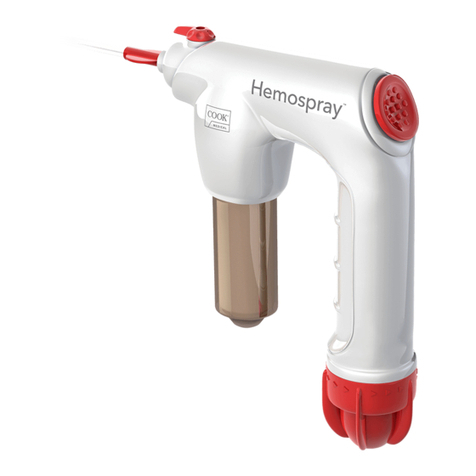
COOK Medical
COOK Medical Hemospray Quick reference guide
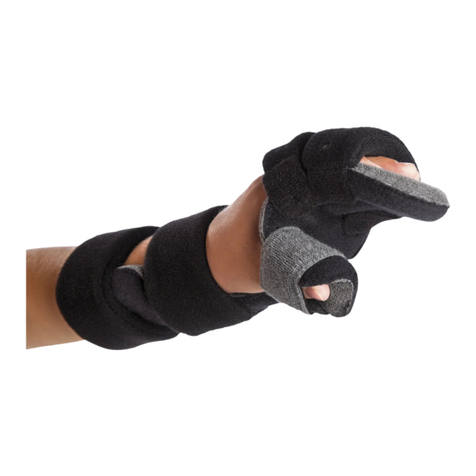
Orliman
Orliman OM6101 INSTRUCTIONS FOR USE AND PRESERVATION
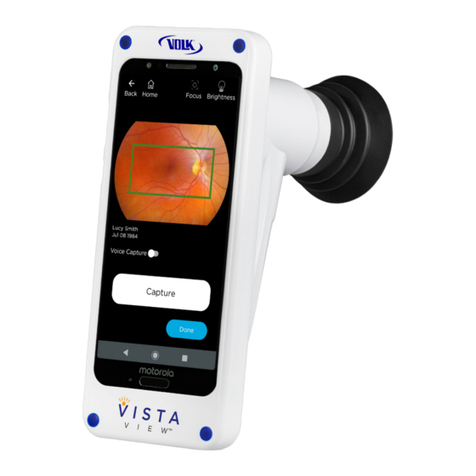
Volk
Volk VistaView Instructions for use
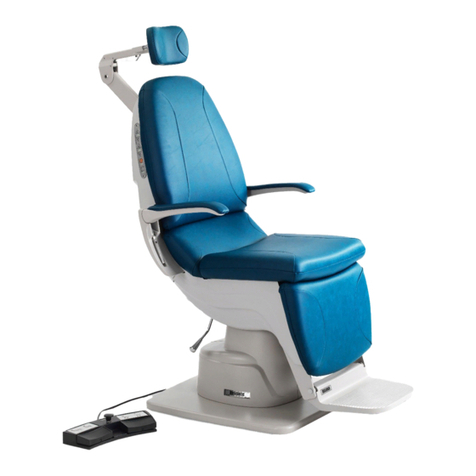
Reliance
Reliance FX920 INSTALLATION AND OPERATING INSTRUCTIONS, OWNERS MANUAL
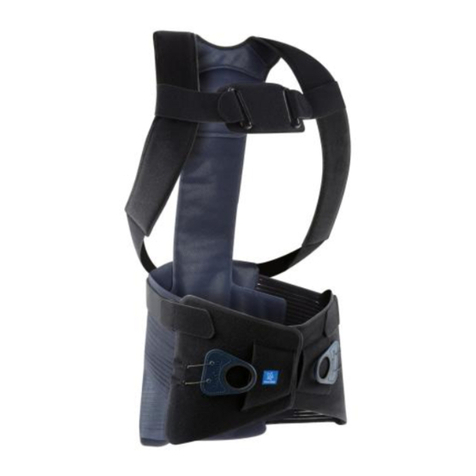
Thuasne
Thuasne LombaStab Dorso manual

Supera
Supera Pureline OC8000 Operator's manual
